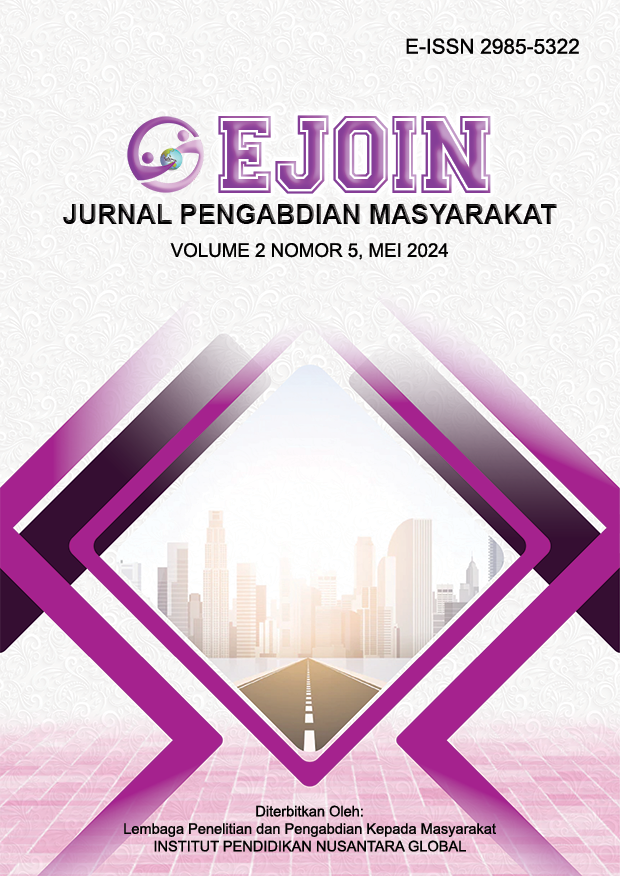PELATIHAN PEMBUATAN BAKSO UNTUK PENGGERAK PEREKONOMIAN USAHA RUMAHAN PADA DASAWISMA KEMUNING KELURAHAN KORUMBA KOTA KENDARI
Keywords:
Community Service, Fish Balls, Household ScaleAbstract
Fish-balls Processing businesses in Korumba Subdistrict, Kendari City, are generally home industry that are conducted to fill leisure time and in form household scale. This product can be enriched with Moringa leaves and chopped carrots, which are the source of vegetable protein and fiber. The target of community service is Dasawisma Kemuning which has 10 members. The objective of these community service efforts is to enhance the knowledge and abilities of Dasawisma Kemuning members in terms of (1) the production process of fish balls in healthy way and nutritious; (2) principles of making hygienic functional fish balls (3) business implementation of processed functional fish ball products that enriched with Moringa leaves and chopped carrots on a household scale; (4) the benefits of processed fish ball products as functional food that is cheap, healthy and nutritious. Derived from the entirety of training activities, not only in discussions, but also in demonstrations of making functional fish balls. The findings indicated that participants' understanding of the training content improved significantly, rising from an average score of 27.55% before the training to 98.25% in the final evaluation. Based on field implementation from the functional fish ball business shows that a raw material requirement of 2 kg/day, 295 fish balls were obtained. Based price per item of IDR 1100,- a profit/month of IDR is obtained. 3,135.00,-. Calculations of the financial aspects of functional fish balls have been resulting in a BEP value (product units sold) of 746. If in one month you can sell 746 fish balls, all costs incurred in a month are covered.
Downloads
References
Aeni, N. (2021). Pandemi COVID-19: Dampak Kesehatan, Ekonomi, dan Sosial. Jurnal Litbang, 17(1), 17–34. http://
Aryanta, I. W. R. (2019). Bawang Merah dan Manfaatnya Bagi Kesehatan. Jurnal Widya Kesehatan, 1(1), 1–7.
Dewi, P. F. A., Widarti, A., & Sukraniti, D. P. (2018). Pengetahuan Ibu Tentang Ikan dan Pola Konsumsi Ikan pada Balita di Desa Kedonganan Kabupaten Badung. Journal of Nutrition Science, 7(1), 16–20.
Irwan, Z. (2020). Kandungan Zat Gizi Daun Kelor (Moringa Oleifera) Berdasarkan Metode Pengeringan. Jurnal Kesehatan Manarang, 6(1), 69–77. http://jurnal.poltekkesmamuju.ac.id/index.php/m
Marhaeni, L. S. (2021). Daun Kelor (Moringa oleifera) Sebagai Sumber Pangan Fungsional dan Antioksidan. Jurnal Agrisia, 13(2), 40–53.
Pamungkas, P., Bahar, A., Nurlaela, L., & Gita, M. (2021). Keunggulan Penambahan Wortel (Daucus carota L.) pada Beberapa Kue Tradisional Indonesia. Jurnal Tata Boga, 10(3), 511–518.
Rahmayani, Yaumi, N., & Agustini, F. (2017). Carbed (Carrot Bread) sebagai Sayuran Instan untuk Anak Kekurangan Vitamin A. Industrial Research Workshop and National Seminar, 110–116.
Riyanto, S., & Mardiansjah, F. H. (2018). Pengembangan Industri Pengolahan Perikanan dalam Pengembangan Ekonomi Lokal. Jurnal Litbang, XIV(2), 107–118.
Saputra, A., Arfi, F., & Yulian, M. (2020). Analisis Fitokimia dan Manfaat Ekstrak Daun Kelor (Moringa oleifera). Jurnal Amina, 2(3), 114–119.
Sri Kumalaningsih. (2007). Antioksidan Alami : Penangkal Radikal Bebas. Sumber, Manfaat, Cara Penyediaan, dan Pengelola. Trubus Agrisarana.
Suryandari, M., Kusumo, G. G., & Ferdinan, A. (2022). Identifikasi Senyawa Metabolit Sekunder Ekstrak Kulit Bawang Putih (Allium sativum). Jurnal Komunitas Farmasi Nasional, 2(2), 388–396.
Wijayanti, A., Emilyasari, D., Rahmawati, S. H., & Qulubi, H. (2023). Karakteristik dan Uji Organoleptik Bakso Ikan Gabus (Channa striata) dengan Penambahan Tepung Porang (Amorphophallus oncophyllus). Jurnal Ilmu Perikanan Dan Kelautan, 5(1), 73–82.
Downloads
Published
Issue
Section
License
Copyright (c) 2024 Norma Arif, Bahari, Doddy Ismunandar Bahari, Astrid Indalifiany, Husnaeni

This work is licensed under a Creative Commons Attribution-ShareAlike 4.0 International License.









